VOLUME OF 3D SHAPES QUESTIONS WITH ANSWERS
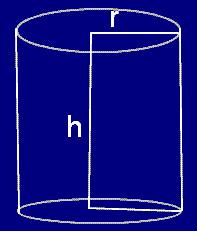 |
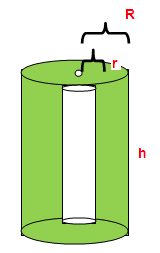 |
|
Volume = Πr2h |
Volume = Πh(R2 - r2) |
 |
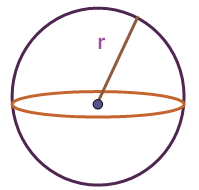 |
|
Volume = (1/3) Πr2h |
Volume = (4/3) Πr3 Volume of hollow sphere = (4/3) Π(R3 - r3) |
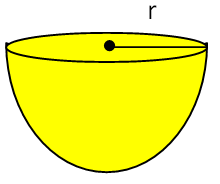 |
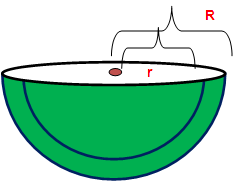 |
|
Volume = (2/3) Πr3 |
Volume = (2/3)Π(R3 - r3) |
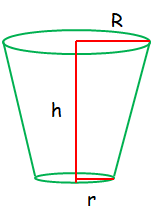 |
Volume = (1/3)Πh(R2 + r2 + Rr) |
Example 1 :
A right angled triangle whose sides are 6 cm, 8 cm and 10 cm is revolved about the sides containing the right angle in two ways. Find the difference in volumes of the two solids so formed.
Solution :
The longest side of a triangle is 10 cm
If the triangle is revolved about 6 cm

r = 6 cm and h = 8 cm
Volume of solid, when it is revolved about 6 cm,
= (1/3)πr2h
= (1/3)π 62 (8)
= 96π cm3
Volume of solid, when it is revolved about 8 cm,
r = 8 cm and h = 6 cm
= (1/3)πr2h
= π 82 (6)
= 128π cm3
Difference = 128π - 96π
= 32π cm3
= 32(22/7)
= 100.5 cm3
Example 2 :
The volumes of two cones of same base radius are 3600 cm3 and 5040 cm3. Find the ratio of heights.
Solution :
Let "h1" and "h2" be the heights of 1st and 2nd cone.
Volume of 1st cone = 3600 cm3
(1/3)πr2h1 = 3600 cm3
Volume of 2nd cone = 5040 cm3
(1/3)πr2h2 = 5040 cm3
h1 : h2 = 3600 : 5040
h1 / h2 = 3600 / 5040
h1 : h2 = 5 : 7
Example 3 :
If the ratio of radii of two spheres is 4 : 7, find the ratio of their volumes.
Solution :
Radius of 1st sphere (r1) = 4x
Radius of 2nd sphere (r2) = 7x
Volume of sphere = (4/3) πr3
(4/3) πr13 : (4/3) πr13
(4x)3 : (7x)3
64 : 343
Example 4 :
A solid sphere and a solid hemisphere have equal total surface area. Prove that the ratio of their volume is 3 √3 : 4 .
Solution :
Total surface area of sphere = 4πr12
Total surface area of hemisphere = 3πr22
4πr12= 3πr22
r12= (3/4)r22
r1 = (√3/2)r2
Volume of sphere = (4/3) πr13
Volume of hemisphere = (2/3) πr13
(4/3) πr13 : (2/3) πr23
2((√3/2))3 : r23
2(3√3/8) r23: r23
3√3 : 4
Hence it is proved.
Example 5 :
The outer and the inner surface areas of a spherical copper shell are 576π cm2 and 324π cm2 respectively. Find the volume of the material required to make the shell.
Solution :
Outer curved surface area of sphere = 4πR2
Inner curved surface area of sphere = 4πr2
4πR2 = 576π
R2 = 576/4 = 144
R = 12
4πr2 = 324π
r2 = 324/4 = 81
r = 9
Volume of sphere = (4/3) π (R3 - r3)
= (4/3) π (123 - 93)
= (4/3) π (1728 - 729)
= (4/3) π (999)
= 1332(22/7)
= 4186.28 cm3
Example 6 :
A container open at the top is in the form of a frustum of a cone of height 16 cm with radii of its lower and upper ends are 8 cm and 20 cm respectively. Find the cost of milk which can completely fill a container at the rate of ₹40 per liter.
Solution :
Volume of milk in the frustum container
= (1/3)Πh(R2 + r2 + Rr)
h = 16 cm, r = 8 cm, R = 20 cm
= (1/3)Π (16)(202 + 82 + 20(8)) - Πr2
= (22/7) [(1/3)(16)(202 + 82 + 20(8)) - 64]
= (22/7) [(1/3)(16)(624) - 64]
= (22/7) [3264]
= 10258.28 cm3
1000 cm3 = 1 liter
= 10.25828 liter
Cost per liter = ₹40
= 40(10.258)
= ₹410.32
Example 7 :
If each side of a cube is increased by 10%. What is the percentage increase in surface area of the cube ?
Solution :
Side length of the cube = x
Side length is increased by 10%. Then new side length = 110% of x
= 1.10x
Surface area of cube = 6a2
= 6(1.10x)2
= 6(1.21x2)
= 7.26x2
Percentage increase or decrease
= { |old value - new value| / old value } x 100%
= {|7.26x2 - 6x2| / 6x2} x 100%
= {1.26x2/6x2} x 100%
= 0.21x2 x 100%
= 21%
Example 8 :
The internal and external diameters of hollow hemispherical vessel are 24 cm and 25 cm respectively. If the cost of painting 1cm2 surface area is $1.5, find the total cost of painting the vessel all over.
Solution :
Internal diameter = 24 cm
radius (r) = 12 cm
External diameter = 25 cm
Radius (R) = 25/2
Surface area of hemisphere = 2Π(R2 - r2)
= 2 x (22/7) x ((25/2)2 - 122)
= 2 x (22/7) x ((625 - 576)/4)
= 2 x (22/7) x (49/4)
= 77 cm2
Total cost of painting = 1.5 x 77
= $115.5
Example 9 :
The surface area of a sphere of radius 5 cm is five times the area of the curved surface area of a cone of radius 4cm. Find the height of the cone
Solution :
Surface area of sphere = 5(surface area of cone)
4πr2 = 5(πrl)
radius of sphere = 5 cm
radius of cone = 4 cm
height of cone = h
l = ?
4π(5)2 = 5(π(4)l)
100 / 20 = l
l = 5 cm
l² = h² + r²
5² = 4² + h²
h² = 25 - 16
h = 3 cm
So, height of the cone is 3 cm.
Kindly mail your feedback to v4formath@gmail.com
We always appreciate your feedback.
©All rights reserved. onlinemath4all.com
Recent Articles
-
Digital SAT Math Problems and Solutions (Part - 150)
Apr 25, 25 11:46 AM
Digital SAT Math Problems and Solutions (Part - 150) -
AP Calculus AB Problems with Solutions (Part - 19)
Apr 24, 25 11:10 PM
AP Calculus AB Problems with Solutions (Part - 19) -
AP Calculus AB Problems with Solutions (Part - 18)
Apr 24, 25 11:06 PM
AP Calculus AB Problems with Solutions (Part - 18)
